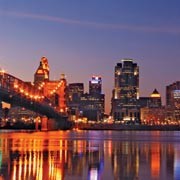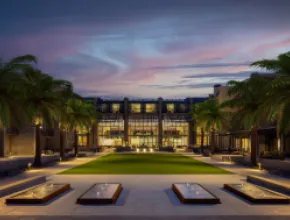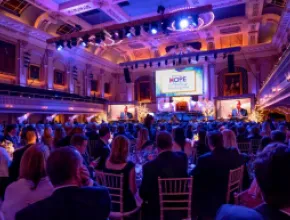Often referred to as the “City of Seven Hills,” Cincinnati is a showcase of American culture and architecture that’s loaded with surprises around every corner.
In fact, one of the biggest surprises is that, unlike that other famous “City of Seven Hills,” Rome, it’s not located on hills at all, at least according to one local purist.
“There’s this misnomer that this is the City of Seven Hills, which has no basis in reality at all,” sniffs historian Dan Hurley, director of Leadership Cincinnati, a program that invites 50 people to spend a year exploring issues that face the community, and who formerly was assistant vice president of history at the Cincinnati Museum Center.
Hurley, who also operates a history consulting business and has been the staff historian at Cincinnati’s CBS affiliate for nearly 30 years, explains that the unique geography of the city often leads to that false impression, although one could certainly understand why.
“The reason that we’re referred to as that is that we have a name that is associated with Rome,” Hurley explains. “Actually, we’re named after the Society of Cincinnati, an organization of Revolutionary War soldiers created by Washington as an example of soldiers returning to the plow after the war and not seizing power themselves.”
And about those “hills?”
“Downtown is in a basin, and there’s this ring of hills on three sides,” he points out. “These are not hills for people from Denver. This is actually a valley built on a plain, and the hilltops are all perfectly flat because they’re the result of glaciers cutting the Ohio River and Valley.”
While that may seem to be splitting hairs, there is no denying the charm of The Queen City.
“If people are interested in architecture, there’s wonderful Art Deco buildings here, such as the Cincinnati Union Terminal—a train station that opened in 1933—Carew Tower and the Netherland Plaza Hotel,” Hurley says. “It’s a very vibrant Art Deco, with much more of a French influence, and very elaborate.”
Urban planners and developers also may take interest in Mariemont, located on the east side of town, which was founded in the 1920s and is basically an English garden village transplanted to southern Ohio. Nearby Greenhills lays claim to being one of three master-planned “Greenbelt Communities” built by the federal government under President Franklin D. Roosevelt in the 1930s, along with Greenbelt, Md., and Greendale, Wis.
Besides elaborate architecture and innovative urban design, Cincinnati also tells a captivating story through its unique ethnic culture.
“Cincinnati is the story of immigration in the U.S.,” Hurley says. “It’s the story of German-speaking Jews coming to Cincinnati.
“This is really the home of [American] Reform Judaism,” he continues. “In terms of world Judaism, this is really one of the important places. The Plum Street Temple is just a beautiful structure inside and out, and just outside is the Roman Catholic cathedral of St. Peter in Chains. Nearby is City Hall, so you have these wonderful buildings with impressive spires interacting with each other.”
For groups visiting Cincinnati, Hurley recommends visiting or having an event at the National Underground Railroad Freedom Center, which opened on the riverfront in 1994.
“The Ohio River was legally the line between slavery and freedom in the pre-Civil War period,” Hurley says of the significance of the facility’s location.
Another off-site event tip is the Cincinnati Museum Center at Union Terminal, which does a lot of event business and boasts “an incredible building,” according to Hurley, who also recommends cruise events on one of the many steamboats that ply the Ohio River out of Covington, Ky.
Of course, no visit to Cincinnati would be complete without a visit to Fountain Square, location of the Tyler Davidson Fountain [no relation to the author of this story!-ed.], an ornate paean to the blessings of water shipped from a Bavarian foundry by local wholesale hardware magnate Henry Probosco to honor his late business partner.
While fans of the late-’70s TV sitcom WKRP in Cincinnati may recognize the fountain from its role as the star of the show’s opening montage, it now serves as the focal point around which locals gather for a leisurely lunch while savoring all the surprises served up by The Queen City.







